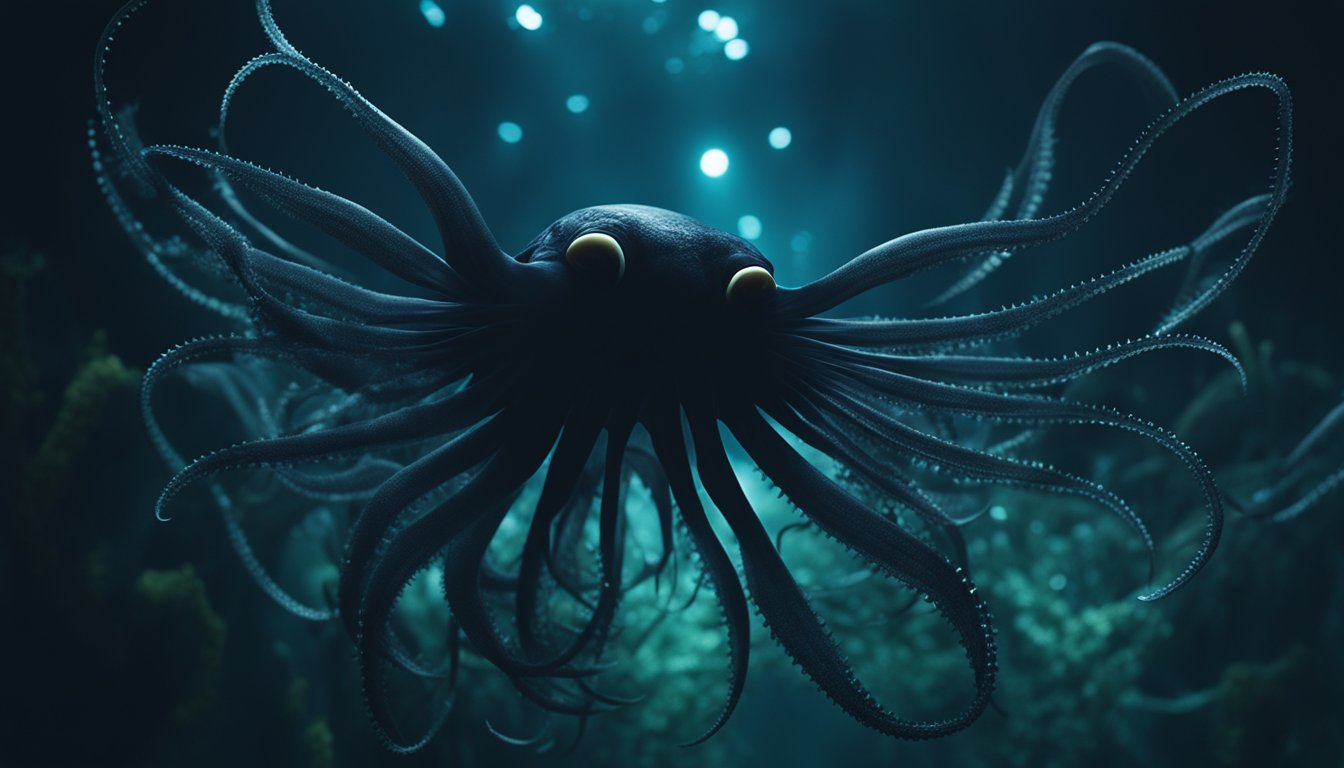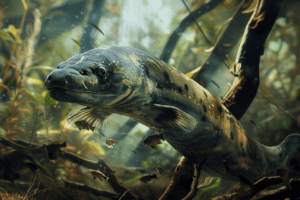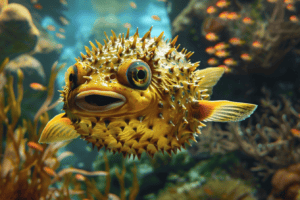The deep sea is a mysterious and fascinating place, home to creatures that have adapted to survive in the extreme conditions of the abyss.
One of the most elusive and enigmatic of these creatures is the vampire squid, a deep-sea cephalopod with a name that sounds like something out of a horror movie.
Despite its ominous moniker, the vampire squid is not actually a bloodsucker, nor is it a true squid.
In fact, this creature is so unique that it has its own taxonomic order, Vampyromorphida.

The vampire squid is a master of camouflage, using its bioluminescent cells to blend in with the faint light of the deep sea.
Its body is covered in a web of skin that can expand to twice its size, making it look much larger and more intimidating to predators.
Despite its fearsome appearance, the vampire squid is actually quite small, only growing to about a foot in length.
Its most distinctive feature is its cloak-like webbing, which it can use to wrap around itself like a cape when threatened.
This, combined with its glowing eyes and the ability to shoot out a cloud of bioluminescent mucus, makes the vampire squid a truly unique and fascinating creature of the deep sea.
Mysteries of the Deep: The Vampire Squid
Anatomy of a Mystery
The Vampire Squid, or Vampyroteuthis infernalis, is a deep-sea cephalopod that has captured the imagination of scientists and the public alike.
This mysterious creature is named for its dark coloration and web-like arms that give it a bat-like appearance.
It has large, bulging eyes that are adapted to see in the low light of the deep ocean, and two long, thin filaments that trail from its body.
One of the most intriguing features of the Vampire Squid is its ability to transform its body shape.
When threatened, it can invert its arms and webbing to form a protective ball, making it difficult for predators to attack.
It can also change the color and texture of its skin, allowing it to blend in with its surroundings and avoid detection.
Despite its name, the Vampire Squid does not suck blood like its namesake.
Instead, it feeds on small crustaceans and other small creatures that drift past it in the ocean currents.
Habitat: Where Darkness Prevails
The Vampire Squid lives in the deep ocean, at depths of up to 3,000 feet.
It prefers areas with low oxygen levels and high levels of organic matter, such as dead animals and plant material.
These conditions are found in the mesopelagic zone, also known as the “twilight zone,” where sunlight does not penetrate and darkness prevails.
The deep sea is a harsh and unforgiving environment, and the Vampire Squid has adapted to survive in these extreme conditions.
Its body is built to withstand the crushing pressure of the deep ocean, and its eyes are highly sensitive to the faintest traces of light.
Despite its elusiveness, scientists have been able to study the Vampire Squid using submersibles and other deep-sea exploration tools.
However, there is still much we don’t know about this fascinating creature, and it continues to be a subject of scientific inquiry and wonder.
Did you know that the Vampire Squid is not actually a squid at all, but belongs to a separate order of cephalopods called Vampyromorpha?
It is one of the few members of this group, which makes it even more unique and mysterious.
Vampire Squid Lifestyle

Feeding Habits
The vampire squid is a unique creature that feeds on a variety of small marine animals, such as copepods, amphipods, and krill.
It has two long filaments that extend from its body, which it uses to capture prey.
These filaments are lined with small hooks that help the squid grab onto its prey.
Unlike other squids, the vampire squid does not have strong jaws or a beak to break down its food.
Instead, it has a unique feeding mechanism that allows it to digest its prey whole.
The squid’s stomach is lined with finger-like projections that help it break down and absorb nutrients from its food.
Reproduction and Lifecycle
The vampire squid has a unique reproductive strategy. Instead of mating, the female lays clusters of eggs that are fertilized by the male.
The eggs are enclosed in a gelatinous mass that protects them from predators.
The squid’s eggs hatch into small larvae that drift in the ocean currents for several months before settling on the seafloor.
Once the larvae settle on the seafloor, they undergo a metamorphosis and transform into juvenile squid.
The juvenile squid grow rapidly and reach maturity within a year. The vampire squid has a lifespan of up to 3 years.
Fun Fact: The vampire squid is not a true squid or an octopus.
It belongs to a unique group of cephalopods called the Vampyromorpha, which means “vampire-like form.”
Conservation Status: Understanding the Threats

The vampire squid is not facing any immediate threat of extinction, but their population size is not well known.
They are not targeted by commercial fisheries, but they may be caught as bycatch. The biggest threat to the vampire squid is climate change.
As the ocean becomes more acidic and warmer, it can affect the squid’s ability to survive and reproduce.
In addition, plastic pollution is also a major concern.
Vampire squid are known to ingest microplastics, which can harm their digestive system and overall health.
It is important to reduce plastic waste and properly dispose of it to protect not only the vampire squid but all marine life.
To better understand the threats facing the vampire squid, research is needed to determine their population size and distribution.
This will help inform conservation efforts and ensure their long-term survival.
Fun fact: Despite its name, the vampire squid does not actually suck blood like a vampire.
Its scientific name, Vampyroteuthis infernalis, means “vampire squid from hell” due to its dark color and web-like cloak.
Frequently Asked Questions

What unique features give the vampire squid its spooky name?
The vampire squid is a deep-sea creature that has a unique appearance.
Its name comes from its dark red color and webbing between its tentacles that resembles a black cape.
The vampire squid also has large blue eyes that glow in the dark, adding to its spooky appearance.
How does the vampire squid adapt to its deep-sea environment?
The vampire squid lives in the deep sea, where it has to adapt to extreme conditions such as high pressure and low temperatures.
It has a gelatinous body that allows it to float effortlessly in the water and escape predators.
The vampire squid can also change the size of its body and fins to move quickly through the water or stay still when necessary.
Can you describe the diet of a vampire squid?
The vampire squid is a carnivore that feeds on small animals such as copepods and amphipods.
It has two long feeding tentacles that it uses to capture prey.
The vampire squid can also use bioluminescence to attract prey or confuse predators.
How does the vampire squid use bioluminescence?
The vampire squid has light-producing organs called photophores that it uses to produce flashes of light.
It can use these flashes to communicate with other vampire squids, attract prey, or confuse predators.
What are the differences between a vampire squid and a dumbo octopus?
The vampire squid and dumbo octopus are two different deep-sea creatures.
The vampire squid has a gelatinous body and two long feeding tentacles, while the dumbo octopus has eight arms and a soft, umbrella-shaped body.
The dumbo octopus also has ear-like fins on its head that it uses to swim.
What efforts are being made to protect the vampire squid from extinction?
The vampire squid is not currently classified as an endangered species, but its deep-sea habitat is being threatened by human activities such as deep-sea mining and fishing.
Scientists are studying the vampire squid to better understand its behavior and habitat, and to develop strategies to protect it and other deep-sea creatures from extinction.









